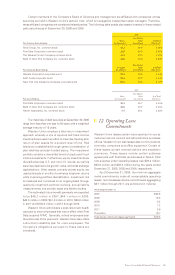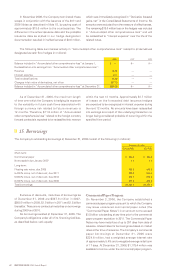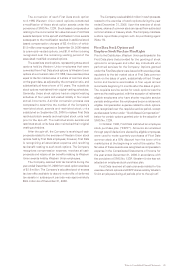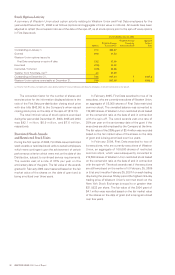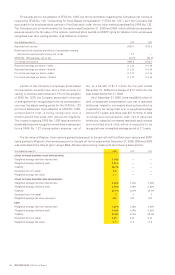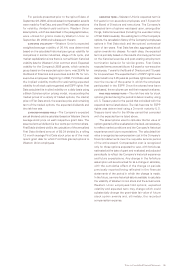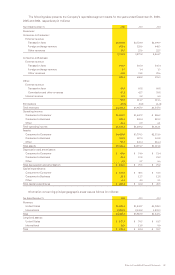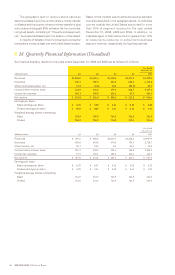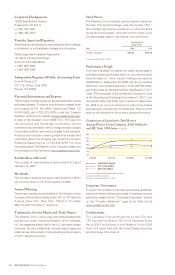Western Union 2006 Annual Report Download - page 97
Download and view the complete annual report
Please find page 97 of the 2006 Western Union annual report below. You can navigate through the pages in the report by either clicking on the pages listed below, or by using the keyword search tool below to find specific information within the annual report. Notes to Consolidated Financial Statements 95
For periods presented prior to the spin-off date of
September 29, 2006, all stock-based compensation awards
were made by First Data, and used First Data assumptions
for volatility, dividend yield and term. Western Union
assumptions, which are described in the paragraphs below,
were utilized for grants made by Western Union on
September 29, 2006 and subsequent thereto.
EXPEC TED VOLATILI T Y
—
Western Union’s expected
weighted-average volatility of 26.4% was determined
based on the calculated historical peer group volatility for
companies in similar industries, stage of life cycle, and
market capitalization since there is not sufficient historical
volatility data for Western Union common stock. Expected
volatility for the Company’s 2006 grants, which varies by
group based on the expected option term, was 28.4% for
the Board of Directors and executives and 24.7% for non-
executive employees. Beginning in 2006, First Data used
the implied volatility method for estimating expected
volatility for all stock options granted and ESPP rights. First
Data calculated its implied volatility on a daily basis using
a Black-Scholes option pricing model, incorporating the
market prices of a variety of traded options, the market
price of First Data stock, the exercise price and remaining
term of the traded options, the expected dividends and
the risk-free rate.
EXPECTED DIVIDEND YIELD
—
The Company’s expected
annual dividend yield is calculated based on Western Union’s
average stock price on each respective grant date. The
assumed annual dividend is four cents per common share.
First Data’s dividend yield is the calculation of the annualized
First Data dividend amount of $0.24 divided by a rolling
12 month average First Data stock price as of the most
recent grant date for which First Data granted options to
Western Union employees.
EXPECTED TERM
—
Western Union’s expected term is
5.8 years for non-executive employees, and 7.5 years for
the Board of Directors and executives. The Company’s
expected term of options was based upon, among other
things, historical exercises (including the exercise history
of First Data’s awards), the vesting term of the Company’s
options, the cancellation history of the Company’s employees
options in First Data stock and the options’ contractual
term of ten years. First Data has also aggregated stock
option awards into classes. For each class, the expected
term is primarily based on the results of a study performed
on the historical exercise and post-vesting employment
termination behavior for similar grants. First Data’s
expected terms were as follows: 4.5 years for non-executive
employees, 7 years for the Board of Directors and 7.5 years
for its executives. The expected term of ESPP rights were
determined to be 0.25 years as purchase rights are achieved
over the course of the quarter in which the employee
participated in the ESPP. Once the shares have been
purchased, the employee can sell their respective shares.
RISK-FREE INTEREST RATE
—
The risk-free rate for stock
options granted during the period is determined by using
a U.S. Treasury rate for the period that coincided with the
expected terms listed above. The risk-free rate for ESPP
rights was determined using a 3-month maturity U.S.
Treasury bond rate for the 90-day period that coincided
with the expected terms listed above.
The assumptions used to calculate the fair value of
options granted will be evaluated and revised, as necessary,
to reflect market conditions and the Company’s historical
experience and future expectations. The calculated fair
value is recognized as compensation cost in the Company’s
financial statements over the requisite service period
of the entire award. Compensation cost is recognized
only for those options expected to vest, with forfeitures
estimated at the date of grant and evaluated and adjusted
periodically to reflect the Company’s historical experience
and future expectations. Any change in the forfeiture
assumption will be accounted for as a change in estimate,
with the cumulative effect of the change on periods
previously reported being reflected in the financial
statements of the period in which the change is made.
In the future, as more historical data is available to calculate
the volatility of Western Union stock and the actual terms
Western Union employees hold options, expected
volatility and expected term may change which could
substantially change the grant-date fair value of future
stock option awards and, ultimately, the recorded
compensation expense.


